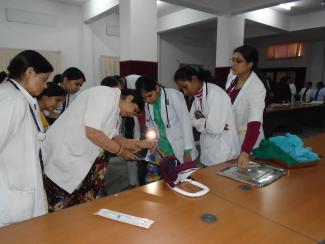Dr. Sharad Singh from Population Services International (PSI) recalls the story of a new young mother, Sarita.* “She held her newborn daughter and promised her the best of everything. This silent conversation was suddenly interrupted by the image of her neighborhood friend who had three children in four years,” Dr. Singh says. Sarita asked her doctor if there was a family planning method available to her to space out her next birth. She was informed of the intrauterine device (IUD) but was told that she would have to wait 6 weeks before insertion because the hospital did not have available instruments for a postpartum IUD insertion. The health staff deeply regretted having to send Sarita away even though she had voluntarily requested an IUD immediately following childbirth. They decided to discuss this issue in their meeting with the Federation of Obstetric and Gynecological Societies of India (FOGSI) to figure out how they could obtain a postpartum IUD in their facility. This is when they were introduced to PSI’s prototype of the PPIUD, or the postpartum IUD, that could be inserted up to 48 hours following childbirth. Does it work? Is there proof of concept? Is it safe? These are the questions that led to Dr. Singh and PSI taking the lead on this issue and applying to a Saving Lives at Birth grant. Like Sarita, almost 885 million women worldwide wish to avoid or delay pregnancy, and about three-quarters of these women are currently using a modern contraceptive method. Yet, more than 214 million women still have an unmet need for family planning.
Reaching postpartum women with family planning services in the developing world can be especially difficult because of barriers including lack of funds for transportation to return to a hospital. The IUD is a tiny t-shaped device that is placed in the uterus to prevent pregnancy. This method is long term, reversible, and an effective method of family planning. The traditional IUD cannot accommodate the shape of a woman’s larger postpartum uterus. Until recently, there was no instrument or device specifically designed for IUD insertion in the immediate postpartum period. Dr. Sharad Singh wanted to change this by developing an IUD that allowed for insertion within 48 hours post-delivery, which would help many more women access voluntary postpartum family planning and save more lives.
PSI partnered with Stanford’s Program for International Reproductive Education and Services and Pregna to develop the PPIUD, or the postpartum IUD, to address the drawbacks of traditional IUD insertion. Traditional insertion procedures require intensive training and tools that are not always available in low-resource settings. The PPIUD is made from stiff, yet flexible rubber that can fit into the shape of the postpartum uterus and comes in a preloaded “ready to use” insertion sleeve. This eliminates the need for specialized instruments as well as the risk for contamination or infection. Additionally, the string used in the PPIUD is longer than in the traditional IUD. This visibility allows health providers to know that the IUD is properly placed. Lastly, the insertion technique is standardized and easy to learn. This technology for new mothers in the developing world eliminates the hassle of figuring out how to return to a health facility for a family planning visit.
In 2013, Dr. Singh and her team became finalists for Saving Lives at Birth and were awarded a grant to test their innovation in hospitals in India. Their proof of concept study tested the safety, acceptance, feasibility, and efficacy of the PPIUD. “USAID has provided us with guidance and global outlook. They enabled us to share this study in peer journals, scientific forums, as well as the DevelopmentX event which has created immense interest by the global audience for our innovation,” says Dr. Singh.
The study results were very promising and showed that the PPIUD worked exactly as intended and the vast majority of insertions were successful. Mothers who received the device felt very comfortable with the inserter and said they had not experienced any difference in pain before and after insertion. Every single woman who received the device for the study said that the provider met or exceeded expectations and 99% said the overall experience of having the device inserted met or exceeded expectations. Service providers were also very happy with the device and said it was a sterile pack that was convenient, easy to use, and eliminated chance for contamination or infection. Today, the PPIUD contributes to about 80% of postpartum family planning methods provided in Public Health system in India.
The PSI team is taking steps to make their device available on the market in India. They are current finalists for a transition to scale award in round 7 of Saving Lives at Birth. Ongoing USAID support will allow them to bring their product to scale and increase uptake of the PPIUD among women and health providers in India, to introduce the device in Uganda, and to develop a global sustainability strategy.
**Name has been altered for privacy purposes

Population Services International
